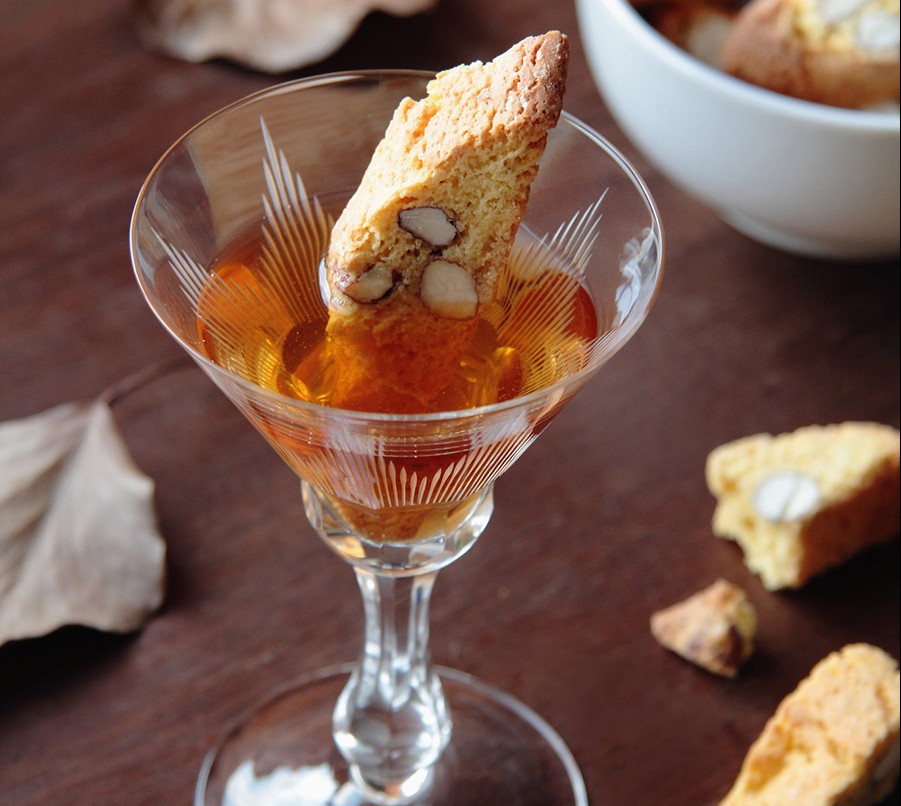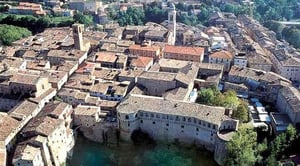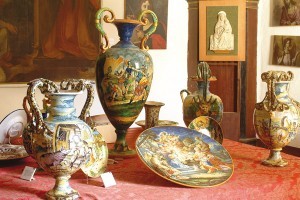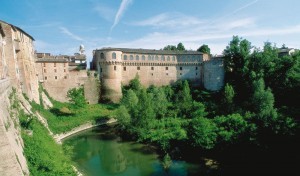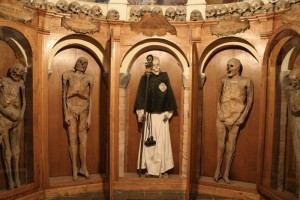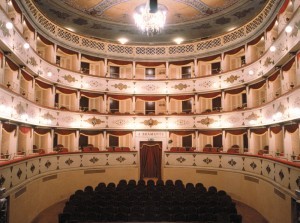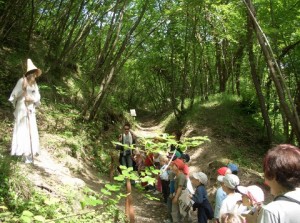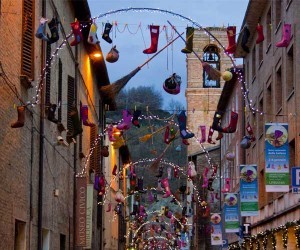Onion, salt and ancient knowledge passed down throughout the Middle Ages to modern times: that's how local people still predict the weather in Urbania.
This lovely town of Le Marche hinterland has lots of surprises in store for you and your family. Located in a quiet valley of the pre-Apennines of Umbria and Le Marche, it is the ideal destination to experience local traditions of the past.
Artisan traditions of Urbania
During the Renaissance, when the town of Urbania was still known as Casteldurante, its production of fine ceramics was intended for wealthy clients from all over Europe and today you can admire some splendid examples in the most prestigious museums in the world. During your first visit to Urbania, you cannot miss the Civic Museum and the Diocesan Museum, with their rich collections of ceramics, drawings and engravings made by renowned artists which served as draft for decoration. This ancient tradition still lives in the artisan workshops and through citizens' associations that organize courses and events, such as the Festival of Ceramics taking place outdoors in the historic centre of the town during the month of July involving both local masters and popular guests. For the occasion, the town squares, streets and courtyards become real workshops for production.
The Ducal Palace
Let's start our visit thorugh the beauties of the historic centre from this imposing building which overlooks the river Metauro and offers a picturesque view. The palace houses the Library and the Civic Museum which contain ancient and rare books, paintings, collections of ceramics, drawings and engravings by masters such as Federico Barocci and Raffaellino del Colle. Especially valuable the two geographical globes created by Gerard Kremer (italianised to the Mercatore, 1512-1594) - a humanist and scholar of mathematical science applied to cartography. The beautifully decorated globes respectively represent the terrestrial and the celestial sphere. A short historical note: the building was designed in 1470 by two great architects - Francesco di Giorgio Martini on behalf of Federico da Montefeltro, Duke of Urbino, and Girolamo Genga who completed it. Through a spiral staircase you reach the cellars of the palace, which host the Museum of Agriculture and Crafts History. Here, environments of everyday rural life have been recreated gathering objects and working tools of that times.
Palazzo Ducale, Museo Civico e Biblioteca Corso Vittorio Emanuele, 23
tel - fax +39 0722 313151 museo@marcheweb.com
The Cathedral
This Cathedral is dedicated to St. Christopher - patron of travellers and motorists, besides being patron of Urbania - and it preserves the relic of the saint's humerus. A curious event linked to tradition and existing from the 1920s is the blessing of vehicles with the relic of the saint, held every July the 25th. The building has undergone major renovations over the centuries: you can still see the bell tower of the original abbey church of the IX century, while the other interventions in the neoclassical style were made in the mid 1700s.
A "noir" touch: the Church of the Dead and the Mummy Cemetery
A Gothic atmosphere prevails in this XIV century oratory which houses the mummified bodies of eighteen people originally buried in the cemetery behind the chapel and then revealed as a result of exhumations carried out in the early XIX century. Thanks to a natural process probably due to a fungus in the soil, the mummies still retain skin, hair and internal organs such as the heart of a young man pierced by a dagger while he was dancing at a vigil feast. These eighteen bodies have been the subject of extensive scientific investigations and every year their stories capture the interest of thousands of visitors.
Listen to the testimony of the Church of the Dead's keeper.
Mummies of Urbania – Church of the Dead, via F. Ugolini
Contact reference for tours: tel. +39 349 8195469 Giovanni Maestrini (guide and keeper)
The Bramante Theatre
This theatre in horseshoe shape with three orders of boxes and a gallery with balcony is a little jewel. It was inaugurated in 1864 with the opera 'Il Trovatore' by Giuseppe Verdi and named after Donato Bramante, one of the greatest architect and painter of the Renaissance, who was born in Urbania.
Group visits: Tourist and Culture office – tel. +39 0722 313140
The Barco Ducale
This magnificent XVIII century complex is located at about 1 km from the town centre, along the main road that leads to Sant'Angelo in Vado. It was originally a hunting park of the Montefeltro family and subsequently of the Della Rovere Dukes and was supposed to be a place for spiritual refreshment and entertainment. It currently houses the activities promoted by the Civic Museum and the Association 'Amici della Ceramica' (Friends of Ceramics).
Centre of Italian Studies
Urbania is home to the first school of Italian language and culture for foreigners in Le Marche region. Established in 1986 it has hosted more than 15,000 students from over 120 countries of all continents. Highly qualified teachers organize Italian courses at different levels for students of any age. Interesting and flexible lessons are held for small groups to facilitate interaction and learning. Every summer this school welcomes the "Opera Festival Studies Centre", for opera singers and musicians who wish to improve their language skills.
Via Boscarini, 1
www.centrostuditaliani.org – www.operafestival.it
For Kids and Grownups...
In the beautiful panorama of the Montiego Mount and the valleys of the rivers Metauro and Candigliano, at about 5 km from Urbania, the Environmental Education Centre San Martino has created an educational, environmental, tourist track called 'Bosco dei Folletti' (Forest of Elves). Younger children are guided by fairy-tale characters along a path of about 1,500 meters, where they'll come across small houses, statues of elves and animal silhouettes. They'll be involved in many activities related to the environmental culture and country traditions. This place is perfect for the whole family, giving the possibility to choose among different activities including guided tours of the farm with its funny animals, of the orchard, of the organic garden and of the museum of agricultural tools. Mum and dad can also enjoy the thrill of sliding down on a double-cable ropeway of 30 meters.
For further information and visits: Bosco dei Folletti – C.E.A. San Martino – Santa Maria in Campolungo, Loc. San Martino www.boscodeifolletti.it
The National Festival of Epiphany
This famous event that attracts thousands of visitors from all over Italy and abroad takes place every year from 2nd to 6th January. Children can visit the 'Befana house', where this little old lady will tell them stories and offer traditional sweets. During the festival there will be food stands, animations, games and shows, parades of Befanas showing the world's longest hand-stitched sock made in Urbania. Each day around 6 pm an agile Befana makes a spectacular descent from the town bell tower. On 6th January an amazing fireworks display closes the event.
Visit the official web site - www.labefana.com - to find out the full programme.
For further information on event calendar, check this section of the town official web site: events calendar.
Culinary delights
Wherever you choose to eat in this area, you'll definitely have the opportunity to taste typical dishes of Le Marche. Highly recommended are local agriturismi, always serving fresh homemade food cooked according to old recipes. A must try: truffle served with handmade pasta, then followed by game and mushrooms as main course. All year round you can enjoy the crostolo (a kind of flat bread but with eggs), to which a festival is dedicated in September. Taste it with salami and local pecorino or stuffed with field herbs. I also suggest you not to miss the delicious snails and finally as dessert, the characteristic bostrengo – a cake made of rice and walnuts, usually accompanied by a fine sour cherry wine or "vin santo" (sweet white dessert wine typical of centre Italy).
